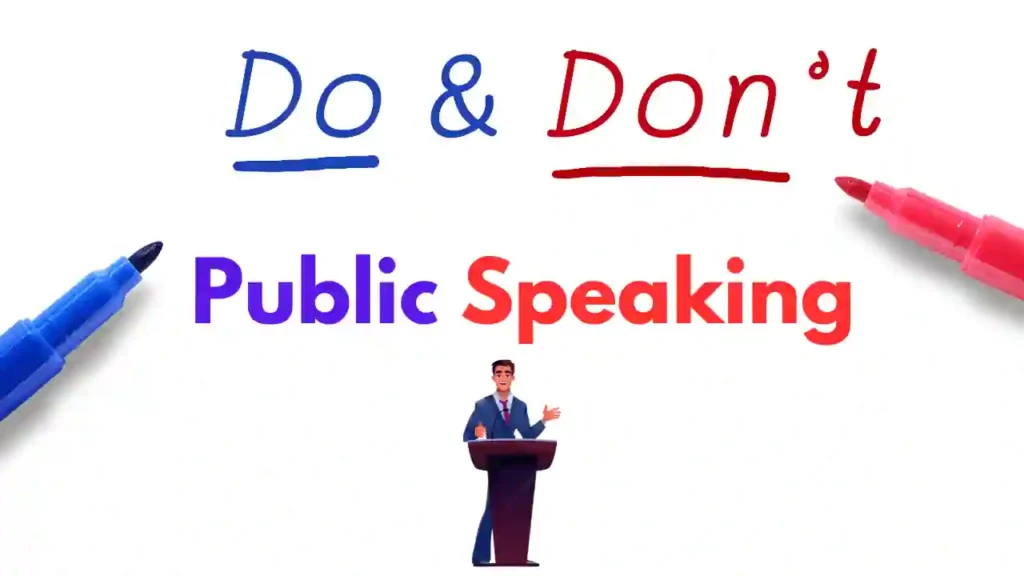Mastering the art of public speaking requires understanding the essential do’s and don’ts of the craft. Public speaking is a skill that can open doors to countless opportunities, whether in professional, academic, or personal settings. However, it’s also a skill that many people find daunting and intimidating. Fortunately, with the right guidance and practice, anyone can become a confident and effective public speaker. In this article, we’ll explore the 10 essential do’s and don’ts of public speaking that will help you captivate your audience, convey your message with clarity, and leave a lasting impression.

10 Do’s and Don’ts of Public Speaking & Its Qualities
1. Do: Know Your Audience
Understanding your audience is paramount to delivering a successful speech. For example, if you’re giving a presentation about environmental conservation to a group of college students, you might incorporate statistics about climate change and share actionable steps they can take to reduce their carbon footprint. Tailor your message and delivery style to resonate with them effectively.
2. Don’t: Overwhelm with Information
Avoid bombarding your audience with too much information. Instead, focus on conveying your key points concisely and clearly. For instance, if you’re giving a sales pitch for a new product, highlight its unique features and benefits rather than delving into technical specifications. Keep your speech well-structured and organized, allowing your audience to follow along easily.
3. Do: Practice, Practice, Practice
The importance of practice cannot be overstated when it comes to public speaking. Rehearse your speech multiple times, focusing on both content and delivery. Practice in front of a mirror, record yourself, or enlist the help of friends or colleagues for feedback. For example, if you’re delivering a TED Talk, you might rehearse your speech dozens of times to ensure every word is delivered with precision and passion.
4. Don’t: Read from Your Slides
While slides can be a helpful visual aid, avoid reading directly from them. Your slides should complement your speech, not duplicate it. Keep text on slides concise and use visuals to enhance key points. Maintain eye contact with your audience and speak naturally. For instance, if you’re giving a business presentation, use slides to showcase charts and graphs that support your main points, while using your spoken words to provide context and interpretation.
5. Do: Use Body Language Effectively
Body language plays a crucial role in public speaking. Stand tall, make eye contact, and use gestures to emphasize key points. Maintain an open and confident posture, and avoid distracting mannerisms such as pacing or fidgeting. For example, if you’re delivering a motivational speech, you might use expansive gestures and energetic movements to convey enthusiasm and passion.
6. Don’t: Rush Through Your Speech
Speaking too quickly can make it difficult for your audience to follow along and absorb your message. Pace yourself and allow for pauses to emphasize important points and give your audience time to digest information. Speak clearly and deliberately, ensuring that every word is heard and understood. For instance, if you’re giving a presentation at a conference, remember to breathe and take your time, even if you’re feeling nervous.
7. Do: Engage Your Audience
Create opportunities for interaction and engagement throughout your speech. Ask questions, encourage participation, or incorporate interactive elements such as polls or group activities. Engaging your audience fosters connection and makes your speech more memorable and impactful. For example, if you’re giving a workshop on leadership skills, you might ask participants to share their own experiences and insights, creating a dynamic dialogue that enriches the learning experience for everyone involved.
8. Don’t: Use Jargon or Complex Language
Avoid using jargon or complex language that may alienate or confuse your audience. Instead, use clear and simple language that is easily understood by everyone. Remember that your goal is to communicate effectively, not to impress with your vocabulary. For instance, if you’re giving a presentation to a non-technical audience, avoid using industry-specific terms and acronyms, opting instead for plain language that everyone can grasp.
9. Do: Be Authentic and Genuine
Authenticity is key to connecting with your audience and building trust. Be yourself, and let your personality shine through in your speech. Share personal anecdotes, stories, or experiences that resonate with your audience and make your message relatable. For example, if you’re delivering a commencement address, you might draw upon your own struggles and triumphs to inspire graduates to pursue their dreams with passion and perseverance.
10. Don’t: Neglect Rehearsing Logistics
In addition to rehearsing your speech content, don’t forget to rehearse logistical aspects such as microphone use, stage presence, and audiovisual setup. Familiarize yourself with the speaking environment and ensure everything runs smoothly on the day of your presentation. For example, if you’re giving a keynote speech at a conference, arrive early to test the microphone and AV equipment, and familiarize yourself with the layout of the stage and auditorium.
Psychological Principles Underpinning the Effectiveness of Following the 10 Do’s and Don’ts of Public Speaking
Understanding the do’s and don’ts of public speaking is essential, but the effectiveness of following these guidelines is underpinned by several psychological principles that influence audience engagement, persuasion, and communication effectiveness. Here are some key psychological principles at play:
1. Attention and Perception:
Principle: The human brain is wired to pay attention to novel, interesting, and relevant stimuli. Effective public speakers capture and maintain audience attention by starting with a compelling opening, using visual aids strategically, and varying vocal delivery to keep listeners engaged.
2. Cognitive Load and Memory:
Principle: Cognitive load theory suggests that individuals have limited cognitive resources for processing information. Speakers avoid overwhelming audiences with information by prioritizing key points, simplifying language, and using clear organization to facilitate comprehension and retention.
3. Social Influence and Persuasion:
Principle: Persuasion theory, including principles from social psychology, guides effective communication strategies. Speakers build credibility and influence by establishing trust, demonstrating expertise, and appealing to audience emotions, needs, and values.
4. Emotional Engagement:
Principle: Emotions play a significant role in decision-making and memory formation. Effective speakers evoke emotional responses through storytelling, personal anecdotes, and empathetic language, creating a deeper connection with the audience and enhancing message retention.
5. Social Identity and Connection:
Principle: Humans are social beings who seek connection and belonging. Speakers foster audience engagement by acknowledging shared identity, values, and experiences, and by actively involving listeners through interactive elements such as questions, group activities, or audience participation.
6. Cognitive Dissonance and Persuasive Messaging:
Principle: Cognitive dissonance theory suggests that individuals experience discomfort when holding conflicting beliefs or attitudes. Effective speakers leverage this principle by highlighting inconsistencies or gaps in audience understanding, then offering solutions or perspectives that align with their message.
7. Self-Efficacy and Confidence:
Principle: Self-efficacy theory posits that individuals’ beliefs in their own ability to succeed influence their performance and motivation. Speakers who demonstrate confidence, competence, and authenticity inspire confidence in their audience, enhancing receptivity to their message and increasing persuasive impact.
8. Social Learning and Modeling:
Principle: Social learning theory suggests that individuals learn by observing and imitating others. Effective speakers serve as role models by exemplifying effective communication behaviors, such as clear articulation, engaging delivery, and empathetic connection, which audience members may emulate.
9. Feedback and Reinforcement:
Principle: Feedback and reinforcement shape behavior and learning. Speakers benefit from seeking feedback from peers, mentors, or audience members to identify strengths and areas for improvement, reinforcing effective communication practices and refining their skills over time.
10. Cultural Sensitivity and Contextual Adaptation:
Principle: Effective communication takes into account cultural norms, values, and expectations. Speakers demonstrate cultural sensitivity and adaptability by tailoring their message, delivery style, and content to resonate with diverse audiences, fostering inclusivity and connection.
By understanding and leveraging these psychological principles, speakers can enhance the effectiveness of their public speaking, engage audiences more deeply, and increase the impact of their messages.

Qualities of a Good Public Speaker
The key qualities of a good public speaker while also delving into the crucial do’s and don’ts of public speaking that contribute to success on the stage.
- Confidence: Confidence is perhaps the most essential quality of a good public speaker. A confident speaker exudes credibility and authority, capturing the attention and respect of the audience.
- Clarity: A good public speaker communicates with clarity, ensuring that their message is easy to understand and digest. They use clear language, logical organization, and concise delivery to convey their ideas effectively.
- Charisma: Charisma is the ability to charm and captivate an audience. A charismatic speaker has a magnetic presence, drawing listeners in with their personality, energy, and enthusiasm.
- Authenticity: Authenticity is key to establishing a genuine connection with the audience. A good public speaker is authentic and sincere, sharing their thoughts, experiences, and emotions in a relatable manner.
- Preparation: Preparation is essential for delivering a successful speech. A good public speaker invests time and effort into researching their topic, organizing their thoughts, and rehearsing their delivery to ensure a polished and professional presentation.
- Engagement: Engaging the audience is crucial for maintaining their interest and attention. A good public speaker uses storytelling, humor, visual aids, and interactive elements to engage the audience and make their message memorable.
- Adaptability: A good public speaker is adaptable and responsive to the needs and reactions of the audience. They can adjust their delivery style, tone, and content on the fly to address questions, concerns, or unexpected situations.
- Empathy: Empathy is the ability to understand and connect with the emotions and perspectives of others. A good public speaker demonstrates empathy by acknowledging the audience’s needs, concerns, and experiences, and tailoring their message accordingly.
- Confidence: Confidence is perhaps the most essential quality of a good public speaker. A confident speaker exudes credibility and authority, capturing the attention and respect of the audience.
- Passion: Passion is contagious, and a good public speaker is genuinely passionate about their topic. They speak with conviction and enthusiasm, inspiring others with their dedication and commitment.
By understanding and embodying these qualities, individuals can become more effective public speakers, making a positive impact on their audience and achieving success in their communication endeavors.
Mastering the art of public speaking requires practice, patience, and a willingness to step outside your comfort zone. By following these 10 do’s and don’ts, you’ll be well-equipped to deliver confident, engaging, and impactful speeches that leave a lasting impression on your audience. So, embrace the challenge, hone your skills, and watch as your public speaking prowess grows with each presentation.
